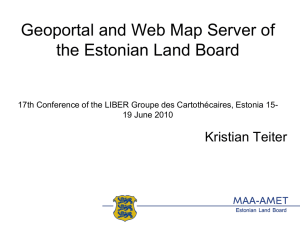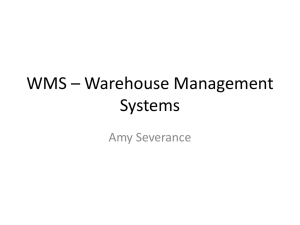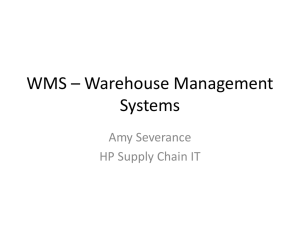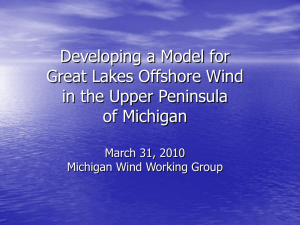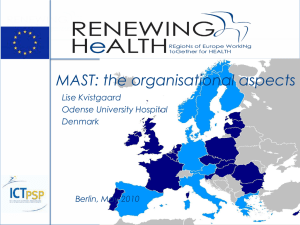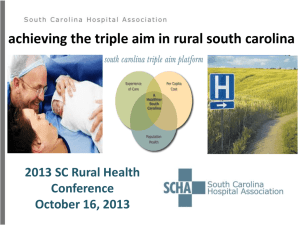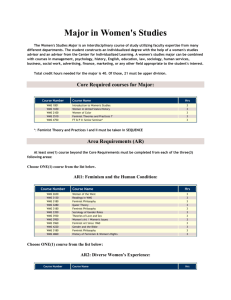TCLHIN Urban Telemedicine Initiative for WMS
advertisement
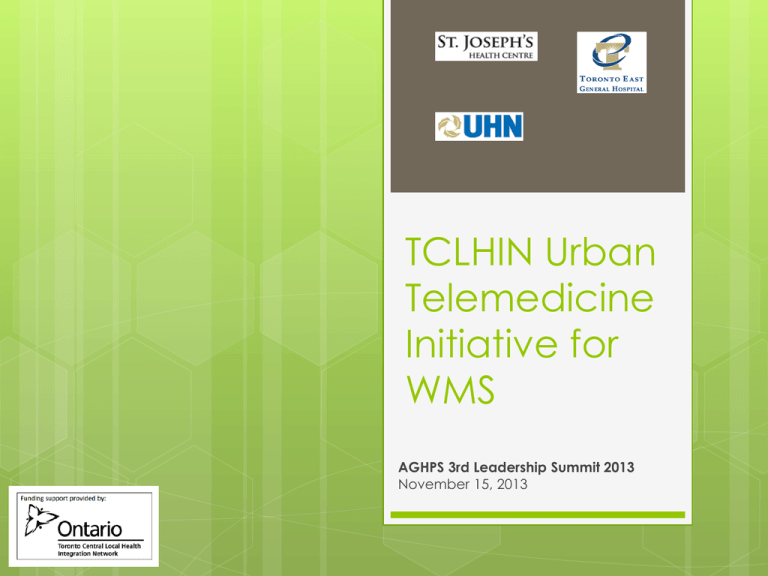
TCLHIN Urban Telemedicine Initiative for WMS AGHPS 3rd Leadership Summit 2013 November 15, 2013 Overview Context - Urban Telemedicine Initiative Urban Telemedicine Model Development Implementation Journey Highlights MOU Documentation Practice Guideline Evaluation Lessons Learned Critical Success Factors Telemedicine Medical support to patients in remote areas History 1900’s - two-way radio connection to Royal Flying Doctor Service of Australia 1950’s to 1990’s – telephone connection to remote areas Late 1990’s - urban telemedicine (Britain, US) via computer 2012 - TC LHIN Urban Telemedicine Initiatives Client and healthcare provider within the same LHIN Mechanism to increase access Withdrawal Management Services (WMS) In TC LHIN Hospital-affiliated, situated off site Separate facilities with some integrated practices Non-medical withdrawal system – care by unregulated health care providers Two-way impact on ED patient flow High level of client medical and withdrawal related complexity Patients go to different sites for episodes of care Drivers for Change ED visits by mental health and addictions clients increasing steadily in TC LHIN Some sites sending every client to ER for medical clearance prior to accepting – bed held at site Many WMS clients have issues accessing primary care and use ED as a substitute Coroner’s Report Urban Telemedicine Model Development Proposal to Charter & Funding – 4 months NP role for model included developing an understanding of: Scope of practice Clinical consultation Medical clearance Primary care focus opportunities Model for sharing resource across sites Telemedicine capabilities Final Model Partnership TEGH – Lead Agency St. Joseph’s Health Center UHN Nurse Practitioner (NP) hired and paid by TEGH NP visits a different site daily while supporting others via Telemedicine Utilize clinical expertise to defer people from ED, provide primary care and WMS staff consultation Milestones Apr’12 1 Initial proposal Funding confirmation (Charter) Telemedicine model 3 development 2 4 NP hiring 5 MOU development 6 OTN installation 7 OTN training 8 NP site orientation Project workflows established Documentation system 10 strategy 9 11 Client care initiated 12 Interim report to LHIN Legend Planned Actual Jul’12 Oct’12 Jan’13 Apr’13 Jul’13 Oct’13 Jan’14 Memorandum of Understanding (MOU) Single MOU Sets out expectations and accountabilities including; Role responsibilities of lead and partner hospitals Human resources and practice accountabilities for NP PHIPA Compliance, Privacy and Health Information Custodianship Policy development Implementation Challenges Expected Actual Technology limitations NP Hiring – need for seasoned clinician Collaboration across hospitals and sites Documentation strategy for accessible record Client perception of telemedicine Privacy considerations across sites Documentation system per site Practice Guideline development Evaluation Framework Implementation Challenges Expected Actual Technology limitations NP Hiring – need for seasoned clinician Collaboration across hospitals and sites Documentation strategy for accessible record Client perception of telemedicine Privacy considerations across sites Documentation system per site Practice Guideline development Evaluation Framework Documentation The Situation Paper based, site-specific client care documentation Existing data extraction software (Catalyst) No budget for electronic medical record Ideal System Unique medical record for each client accessible by NP at any site Supported by pharmaceutical data base Integration of diagnostic test results/ reports Means to flow relevant information for handoff PHIPA compliance Capacity for data extraction The Documentation Journey The Process Several meetings over 6 months with LHIN representation Goal to balance privacy, IT perspective, user needs and available alternatives Considerations Cost Simplicity vs complexity Approval times for external software vendor Access to client health care information by unregulated staff Documentation Options Paper Record Paper Record with Electronic version EMR Catalyst Superuser Paper record One copy Resides in WMS paper chart Staff fax to NP as required for referencing care to make clinical decisions Produced on computer Printed to chart NP keeps documents (ie in Word) for reference on laptop Original in chart EMR installed on laptop, server or web based EMR version is original NP progress note printed for WMS chart ? Site access On Catalyst NP as super-user Partitioned by site visits but contiguous for patient?? Same system as registration WMS Site as custodian WMS Site as custodian TEGH as health Health record records custodian custodian ?? Documentation Decision Model TEGH as health information (HIC) custodian Separate medical record for each client contiguous if care at more than one site NP provides needed clinical information to WMS staff on “as needed” basis Strategy Electronic medical record Web-based access from all sites to ensure timeliness (Application Service Provider) Relevant notes to paper chart Practice Guideline Development Purpose Intent To establish common Urban Telemedicine Initiative practices among sites. Guideline to be a “living” document, reflecting evolving practice. Process Involvement of WMS staff, supervisors, managers and directors in development. Practice Guideline Content Primary Health Care NP Practice Telemedicine Practice Client Eligibility and Priority Referrals to UTM/NP Consultation and Continuity Location, Frequency and Scheduling Documentation Privacy and Consent Health Information Management Telemedicine Assessments Infection Control Evaluation, Program Development, CQI Evaluation Design Conceptual framework Access Integration Patient centered care Safety Development of data elements, definitions, sources, frequency, accountabilities Need for pre-data identified Design of data collection tools and scorecard Reporting accountabilities to LHIN established Key Findings: Client Care A challenge to distinguish unique clients and encounters ED Diversion Rates Clinical Encounters -NP 150 140 100 138 8.0% 99 7.2% 6.9% 6.0% 5.9% 4.0% 50 2.0% 0 July August September 0.0% July High Risk Clients 70.0% 60.0% 64.8% 59.7% 37.9% 30.0% 20.0% 10.0% 0.0% 0.0% July August 49.6% 40.0% 20.0% September September Follow-up Care Ratio 60.0% 50.0% 40.0% 80.0% August July 59.8% August 62.4% September Key Findings: Client Care Trending reasons for a visit 10% 9% 16% 6% Substance Abuse Mental Health Issue Medical Issue 59% Medication Issue System Navigation Issue Key Findings: Patient Satisfaction Metric Number of respondents Jul-Sep 2012 32 Accessibility of the NP 96.9% Excellent quality of care 87.5% Good quality of care 12.5% Impact on self-management: "a lot" 90.0% Impact on self-management: "some" 10.0% Self-estimated diversion 53.1% Use again ? 100.0% Recommend to others? 100.0% 100% 100% Scorecard Scorecard Lessons Learned Our history of voluntary integration and WMS committee structure supported the process of change. New uses of telemedicine are challenging due to already existing definitions for type of engagement. Site differences posed both challenge and opportunity. MOU development can be a lengthy process when combining privacy, human resources and site accountabilities. Lessons Learned Continuous quality improvement (CQI) is an important part of the initiative, to understand impacts and refine practices through small tests of change. There is much work to be done to manage the medical complexity of clients and enhance risk management. In addition to ED diversion, there are several promising practices from this initiative; virtual rounds, CAMH patient flow, using practice guidelines across sites and establishing a means to track ED interfaces through CATALYST. Client Voice "I didn't think I could do this (alcohol withdrawal) - and manage my diabetes and liver cirrhosis at the same time“ 52 year old male: heavy alcohol binge-type use and extensive alcohol use history, admitted from ED After admission to WMS NP noted that client had both medical and withdrawal related risks Client was transferred to the medical Withdrawal Management Service of CAMH (Centre for Addiction and Mental Health) for stabilization of his diabetes and acute withdrawal phase Client then returned to TEGH non-medical WMS site to complete withdrawal and participate in day program, before being admitted to a long-term substance use treatment program During stay at TEGH WMS, NP and client worked to improve client's diabetic control through assessments, health teaching and assistance with system navigation In Summary: Critical Success Factors Ongoing dialogue at many levels to understand complexity of service model Being open to learning and discovering new ways of providing care Building on the strong foundation that exists in WMS to ensure collaborative input at all levels for shaping initiative. Discussion Questions? Suggestions? Contacts Pat Larson TEGH plars@tegh.on.ca Linda Young TEGH lyoun@tegh.on.ca Jan Lackstrom UHN jan.lackstrom@uhn.ca Paula Podolski St. Joseph's Health Center podolp@stjoe.on.ca
